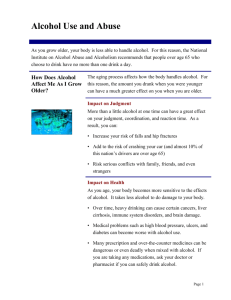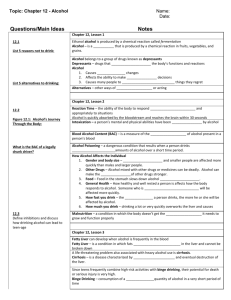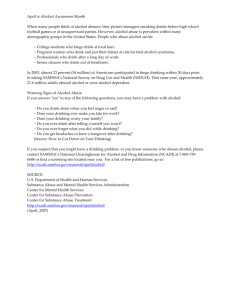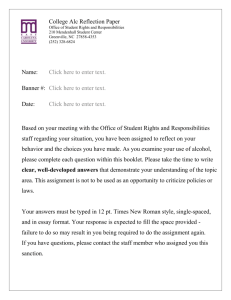Alcohol powerpoint
advertisement
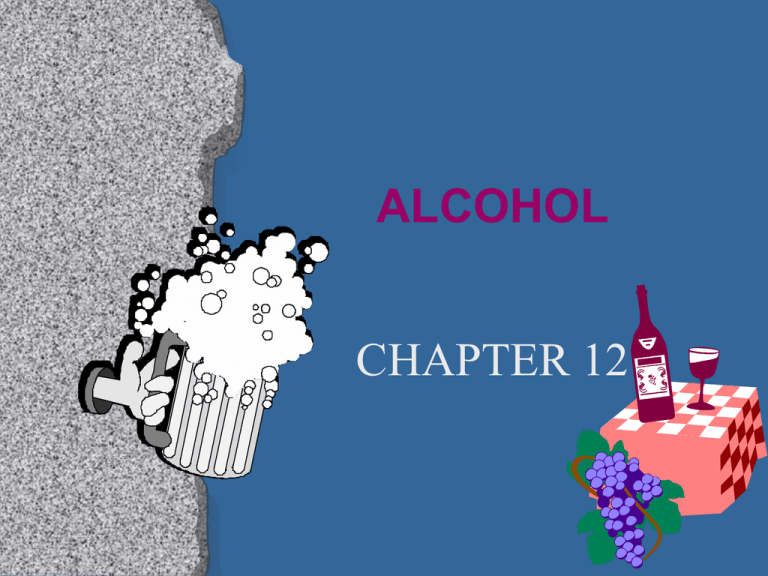
ALCOHOL CHAPTER 12 I. ALCOHOL A drug that is produced by a chemical reaction in fruits, vegetables, and grains. A. ETHYL ALCOHOL Commonly called grain alcohol. Ethanol is the alcohol in beer, wine, and liquor. 1. Made by the FERMENTATION of sugar or yeast. B. DEPRESSANT DRUG SLOWS DOWN THE CENTRAL NERVOUS SYSTEM C. Alternatives to drinking – – – – 1. 2. 3. 4. Sports Theaters Volunteering Advocacy – SADD II. Alcohol and the Body It starts affecting the body the moment it enters the mouth. A. Alcohol will slow your reaction time. – 1. Reaction time is the ability of the body to respond quickly and appropriately to situations. B. Intoxication – Person’s mental and physical abilities have been impaired by alcohol. C. BLOOD ALCOHOL CONCENTRATION THE AMOUNT OF ETHANOL IN A PERSON’S BLOOD IS EXPRESSED BY A PERCENTAGE. D. ALCOHOL POISONING A dangerous condition that results when a person drinks excessive amounts of alcohol over a short period of time. III. BAC A. WHAT EFFECTS BAC: 1. GENDER, AGE, WEIGHT, HEIGHT 2. OTHER DRUGS 3. AMOUNT OF FOOD IN THE STOMACH 4. GENERAL HEALTH 5. HOW MUCH YOU DRINK 6. HOW FAST YOU DRINK IV. LONG-TERM EFFECTS OF ALCOHOL USE A. STOMACH ULCERS SORES IN THE STOMACH DUE TO INCREASED FLOW OF GASTRIC JUICES (HCL) B. CIRRHOSIS –ALCOHOL DESTROYS TISSUE OF LIVER, WHICH IS REPLACED WITH SCAR TISSUE About 15 percent of heavy drinkers develop cirrhosis, which can be fatal. --------------------------------------------------------Excerpted from Compton’s Interactive Encyclopedia Copyright © 1993, 1994 Compton’s New Media, Inc. C. FATTY LIVER FAT BUILDS UP IN THE LIVER AND CANNOT BE BROKEN DOWN D. WET BRAIN DETERIORATION OF BRAIN CELLS V. ALCOHOL USE AND TEEN PREGNANCY A. INHIBITIONS – A conscious or unconscious restraint of a person’s own behaviors or actions. 1. When using alcohol people’s inhibitions are lowered. B. FETAL ALCOHOL SYNDROME CHILD IS BORN SHOWING SIGNS OF PHYSICAL, MENTAL AND BEHAVIORAL ABNORMALITIES RELATED TO ALCOHOL One third of the babies born to mothers who drink heavily, especially during the first trimester, have birth defects or retardation. --------------------------------------------------------Excerpted from Compton’s Interactive Encyclopedia Copyright © 1993, 1994 Compton’s NewMedia, Inc. VI. LEGAL DRINKING LIMIT IN THE STATE OF OHIO .08 FOR ANYONE 21 YEARS OLD .02 FOR ANYONE UNDER LEGAL AGE http://www.centurycouncil.o rg/state-facts Drunk driving facts for 2011 VII. BINGE DRINKING CONSUMPTION OF LARGE QUANTITY OF ALCOHOL IN A VERY SHORT PERIOD OF TIME. VIII. ALCOHOLISM AND ALCOHOL ABUSE A. ADDICTION – Physical or psychological need for a drug. 1. Teens 15 and younger are more likely to become addicted than older individuals. B. ALCOHOLISM An overwhelming desire to drink alcohol, even though it is causing harm, is a disease called alcoholism Excerpted from Compton’s Interactive Encyclopedia Copyright © 1993, 1994 Compton’s New Media, Inc. ---------------------------------------------------------. 1. Major symptoms of alcoholism a. b. c. d. e. Denial Craving Loss of control Tolerance Physical dependence a. STAGE 1 STARTS WITH SOCIAL DRINKING b. STAGE 2 CAN’T STOP DRINKING PHYSICAL AND MENTAL PROBLEMS ARE SHOWN 3. STAGE 3 DRINKING IS UNCONTROLLED ISOLATES SELF PHYSICALLY ADDICTED d. STAGE 4 It’s the only thing the individual can do. They usually can’t hold a job. c. ENABLERS PROTECTS ADDICTS FROM THE RAMIFICATIONS OF DRINKING. 1. LIE FOR THE DRINKER. 2. AVOID GETTING TREATMENT FOR THE DRINKER. d. ALCOHOL ABUSE PATTERN OF DRINKING THAT RESULTS IN ONE OR MORE WELLDEFINED BEHAVIORS WITHIN A TWELVE-MONTH PERIOD. Symptoms of Alcohol Abuse 1. Failure to fulfill major work, school, or home responsibilities. 2. Drinking in situations that are physically dangerous. (Drinking and driving) Symptoms of Alcohol Abuse 3. Having ongoing alcohol-related legal problems. 4. Continuing to drink even when relationships have been negatively affected. IX. Getting Help A. Intervention – Gathering in which family and friends get the problem drinker to agree to seek help. B. Relapse – Return to the use of a drug after attempting to stop. C. Withdrawal - Occurs when a person stops taking the drug. D. Steps to Recovery 1. Admission 2. Counseling 3. Detoxification – Freeing the body of an addictive substance. 4. Resolution – Now a recovering alcoholic.

